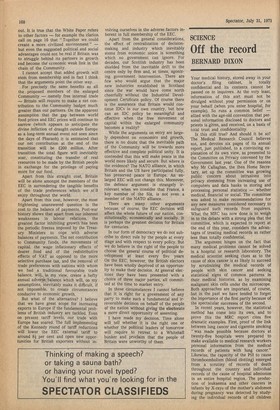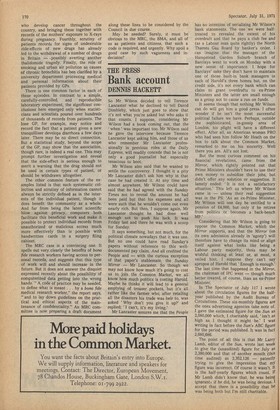SCIENCE
Off the record
BERNARD DIXON
Your medical history, stored away in your doctor's filing cabinet, is totally confidential and its contents cannot be passed on to inquirers. At the very least, information of this sort must not be divulged without yotkr permission or on your behalf (when you enter hospital, for example). So runs a common belief — allied with the age-old convention that personal information disclosed to doctors and priests is given, and received, on a basis of total trust and confidentiality.
Is this still true? And should it be so? The Medical Research Council believes not, and devotes six pages of its annual report, just published, to a convincing explanation of its own view, as presented to the Committee on Privacy convened by the Government last year. One of the reasons why Mr Callaghan, the then Home Secretary, set up the committee was growing public concern about intrusions into privacy stemming from increasing use of computers and data banks in storing and processing personal statistics — whether medical, financial or social. The committee was asked to make recommendations for any new measures considered necessary to safeguard such records from inquirers. What the MRC has now done is to weigh in to the debate with a strong plea that the committee, which is expected to report at the end of this year, considers the advantages of treating medical records as rather less than totally confidential.
The argument hinges on the fact that many medical problems cannot be solved in a hospital or research laboratory. The medical scientist seeking clues as to the cause of skin cancer is as likely to succeed by scrutinizing the medical records of people with skin cancer and seeking statistical signs of common patterns in their medical histories, as by examining malignant skin cells under the microscope. Both approaches are important, of course, but in the past we have tended to forget the importance of the first partly because of the spectacular successes of the second.
In recent years, however, the statistical method has come into its own, and to prove this the MRC report cites five dramatic examples. First, proof of the link between lung cancer and cigarette smoking "was made possible because doctors at twenty-five hospitals were prepared to make available to medical research workers personal information from the medical records of patients with lung cancer." Likewise, the capacity of the Pill to cause thromboembolism (blood clotting) emerged from a scrutiny of records of death throughout the country and individual records of the cause of hospital admission in an entire hospital region. The production of leukaemia and other cancers in infants by .X-rays of the mother's abdomen during pregnancy was detected by studying the individual records of all children who develop cancer throughout the country, and bringing these together with records of the mothers' exposure to X-rays during pregnancy. Fourthly, scrutiny of patients records for signs of undesirable side-effects of new drugs has already led to the withdrawal of a number of drugs in Britain — -possibly averting another thalidomide tragedy. Finally, the role of smoking and urban air pollution as causes of chronic bronchitis has ben clarified by a university department processing medical and personal information about their patients provided by GPs.
There is one common factor in each of these episodes. In contrast to a simple, carefully-controlled, and reproducible laboratory experiment, the significant conclusions here emerged only when statisticians and scientists poured over hundreds of thousands of records from patients. The lone GP, for example, may notice and record the fact that a patient given a new tranquilliser develops diarrhoea a few days later. There may be no direct connection. But a statistical study, beyond the scope of the GP, may show that the association, though rare, is indeed a real one. This may prompt further investigation and reveal that •the side-effect is serious enough to merit a warning that the drug should not be used in certain types of patient, or should be withdrawn altogether.
The other common feature of the examples listed is that such systematic collection and scrutiny of information cannot always be strictly defined as in the interests of the individual patient, though it does benefit the community as a whole. And far from being the latest scientific blow against privacy, computers both facilitate this beneficial work and make it possible to protect individual records from unauthorized or malicious access much more effectively than is possible with handwritten cards in a surgery filing cabinet.
The MRC case is a convincing one. It spells out very,clearly the benefits of bona fide research workers having access to personal records, and suggests that this type of work will and should increase in the future. But it does not answer the disquiet expressed recently about the possibility of computerized data getting into the wrong hands. "A code of practice may be needed, to define what is meant . . . by a bona fide medical research worker," the report says, "and to lay down guidelines on the practical and ethical aspects of the maintenance of confidentiality." An MRC committee is now preparing a draft document
along these lines to be considered by the Council in due course.
May be needed? Surely, it must be obvious to the MRC, the BMA, and all of us as patients and citizens, that such a code is required, and urgently. Why spoil a good case by such vagueness and indecision?











































 Previous page
Previous page